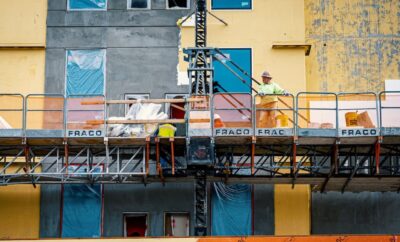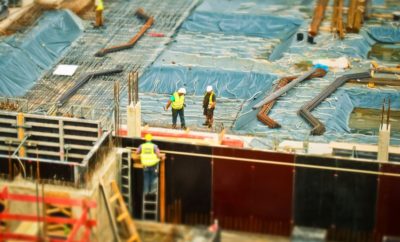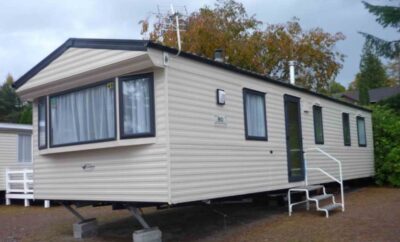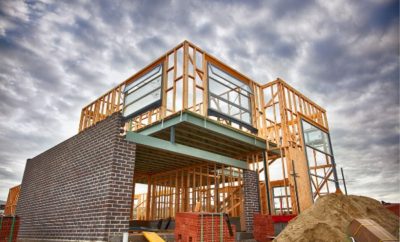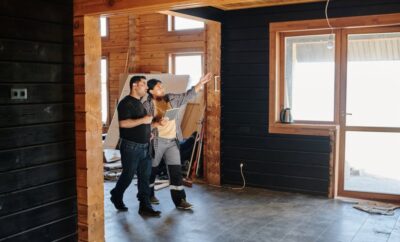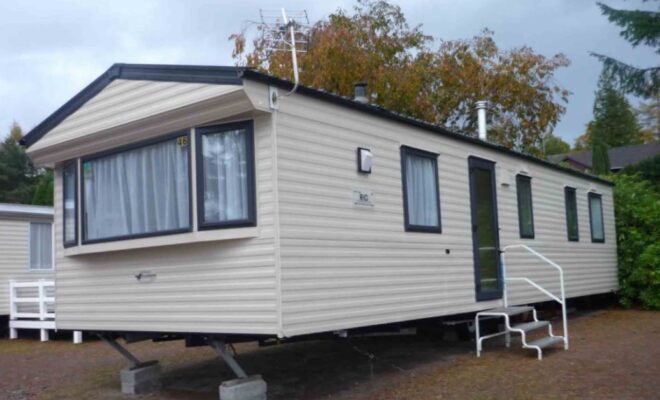
Manufactured Homes: More Affordable Path to Housing in US
Manufactured houses have a significant impact on the US housing market by providing a cheap supply option for millions of people.
According to the American Housing Survey (AHS), there are 7.2 million inhabited manufactured houses in the United States, accounting for 5.4% of total occupied housing and providing affordable housing, particularly to rural and low-income households.
Manufactured homes, often known as “mobile homes” or “trailers,” are a form of factory-built housing that follows the Manufactured Home Construction and Safety Standards regulation established by the United States Department of Housing and Urban Development (HUD).
A manufactured home must be a “movable dwelling, 8 feet or more wide and 40 feet or more long” built on a permanent chassis.
The East South Central division (Alabama, Kentucky, Mississippi, and Tennessee) has the highest concentration of prefabricated homes, accounting for 9.3% of all occupied housing.
The Mountain region follows with 8.5%, and the South Atlantic region has 7.7%.
The 1990s saw a boom in prefabricated home shipments, which peaked in 1998.
During this time period, manufactured homes accounted for 17% to 24% of all new single-family homes1.
However, shipments fell in the early 2000s, coinciding with a surge in site-built housing building prior to the 2008 housing crisis. Since then, manufactured homes have remained stable at about 9% to 10% of new housing.
Characteristics of 2023 Manufactured Home Stock
Given that the majority of mobile houses were developed in the 1990s, roughly 72.2% of the current manufactured home stock was created before 2000. As a result, 7.7% of these dwellings are rated as substandard, compared to 5% of all residences countrywide.
Approximately 2% are regarded highly inadequate and exhibit “major deficiencies, such as exposed wiring, lack of electricity, missing hot or cold running water, or the absence of heating or cooling systems”.
However, with careful upkeep, manufactured homes can be as long-lasting as site-built homes.
According to the AHS, 57% of the inhabited manufactured home stock is currently single-section units, with 43% being multi-sections.
Single-section homes are prefabricated homes that can be carried from the factory to the site in a single piece, whereas multi-section homes are transported in numerous pieces and assembled on-site.
However, Census data suggest that recent shipments imply a move toward multi-section dwellings.
Most single-section homes are fewer than 1,000 square feet and include five total rooms, including two bedrooms and three bathrooms.
Multi-section homes, on the other hand, are typically 1,000 to 2,000 square feet in size and include six rooms, including three bedrooms and three bathrooms.
Demographics of Manufactured Home Residents
Manufactured homes are an important housing choice, especially for individuals living in rural or non-metropolitan communities. The AHS data show a striking discrepancy between the locations of single-family and prefabricated house inhabitants.
While 53% of prefabricated home inhabitants live in rural areas, the majority of single-family residents (67%) live in urbanized areas, which are defined as territory with a population of 50,000 or more.
In comparison, only 33% of prefabricated home inhabitants live in metropolitan settings.
Residents of prefabricated and single-family houses are less numerous in urban clusters (areas with populations of 2,500 to 50,000), accounting for only 13% and 9%, respectively.
The median age of a manufactured home homeowner is 55, which is the same as for single-family households. However, the majority of manufactured home households (37.8%) have completed high school, as opposed to single-family households, the largest group of which (24.8%) has obtained a bachelor’s degree.
Income differences are also considerable. The median household income for manufactured home dwellers is $40,000, which is significantly lower than the $85,000 median income for single-family households. The income disparity among homeowners deepens, with prefabricated homeowners earning a median of $41,500 vs $93,000 for single-family homeowners.
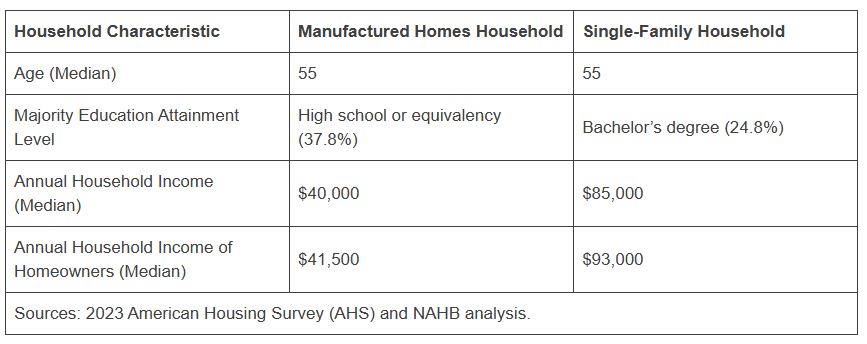
Cost of Purchasing and Owning Manufactured Homes
One of the primary advantages of modular homes is their cost. In 2023, the average cost per square foot for a new prefabricated home was $86.62, compared to $165.94 for a site-built home (excluding land costs), representing a $79.32 difference per square foot.
This pricing differential has only increased over the past decade, from $51.84 per square foot in 2014.
This amounts to a savings of roughly $118,980 for a 1,500-square-foot home, and this savings has grown despite the fact that the average cost of prefabricated homes is increasing at a faster pace of 7.4% CAGR2 compared to 6.1% CAGR for new single-family homes.
Owning a manufactured house also lowers overall housing costs, which include mortgage payments, insurance, taxes, utilities, and lot rent.
According to the AHS, the median total monthly housing cost for a single-section manufactured home is $563, but a multi-section home is $805.
In comparison, the median monthly cost of owning a single-family house is $1,410.
Despite the cheaper costs of manufactured homes, many owners still struggle with affordability.
Among single-section manufactured homeowners, 36.6% are cost-burdened, which means they spend 30% or more of their income on housing.
This is slightly higher than the 28.4% of multi-section prefabricated homeowners and the 27.6% of single-family homeowners experiencing similar financial difficulties.
This gap demonstrates that, despite the fact that manufactured homes are a more cheap option, lower-income households continue to bear a disproportionate share of housing costs.
Manufactured Home Prices
The data on modular house appreciation is sparse. However, the Federal Housing Finance Agency (FHFA) releases a quarterly house price index for manufactured homes.
When comparing the indices for manufactured and site-built homes, manufactured homes have closely tracked the appreciation tendencies of their site-built counterparts.
Between the first quarter of 2000 and the fourth quarter of 2024, the index value for manufactured homes climbed by 203.7%, slightly outpacing the 200.2% increase for site-built homes.
This suggests that prefabricated home markets face many of the same demand possibilities and supply constraints as the overall housing market.
It is important to remember that this data only includes prefabricated houses financed with conventional mortgages and acquired by Fannie Mae and Freddie Mac.
In contrast, the bulk of new manufactured houses are titled as personal property, which is ineligible for conventional mortgage financing because Enterprises do not purchase chattel loans.
Nonetheless, it is common for manufactured homes to be placed on private land, even if the unit is under a personal property title — a title that applies to movable assets such as vehicles, tools or equipment, and furniture, as opposed to a real estate property title, which includes land and any structures permanently attached to it.
Regardless of this distinction, the percentage of manufactured homes titled as real estate has steadily increased.
Since 2014, the share of real estate-titled prefabricated houses has increased from 13% to 20% by 2023, demonstrating a good trend toward better financial recognition and stability for these properties.
Zoning Regulations and the Future of Manufactured Homes
Manufactured homes are an affordable housing option, especially in rural areas where transportation and material costs for site-built homes can be much higher. However, rigorous zoning rules frequently prohibit their placement in metropolitan areas.
Regulations such as prohibitions on mobile home communities and excessive lot size requirements can significantly raise prices, making it impossible to build prefabricated homes in cities.
Reducing these zoning obstacles could increase affordable housing options in high-cost metropolitan locations while also improving access to key services like healthcare and economic opportunities for low-income groups.
Jackson, Mississippi, provides a good example of zoning change. City officials collaborated with the Mississippi Manufactured Housing Association (MMHA) to launch a pilot program demonstrating the possibilities of prefabricated and manufactured homes as affordable housing solutions.
As part of the campaign, the city updated its zoning regulations to differentiate manufactured and modular houses from pre-1976 “mobile homes,” which had previously been prohibited. Previously, manufactured homes were classed in the same category, which limited their placement.
The new rule now allows manufactured housing within city limits, though only with a discretionary use permit, paving the path for increased affordability and accessibility in urban housing.
Finale
Manufactured homes account for only 5% of total housing stock, but they provide an alternative form of dwelling that suits the needs of many households, particularly in rural locations.
Although they are less expensive than site-built dwellings, issues such as aging housing stock, financing difficulties, and zoning restrictions may have an impact on their accessibility and long-term viability.
Trends such as the increasing incidence of multi-section homes and a growing number of real estate-titled units indicate a progressive movement in consumer preferences toward housing options that, in terms of size, functionality, and finance, are increasingly similar to site-built homes.
As housing affordability remains a major challenge, manufactured homes continue to play an important role in the overall housing environment, and increasing their use through education, innovation, and zoning reform could enhance access to low-cost housing.
[Read more about this story on Eyeonhousing.org]


